The tenkile, or the Scott’s tree kangaroo (Dendrolagus scottae) could be a cross between a koala bear and a puppy. With it’s fuzzy dark fur, long tail and snout, and tiny ears, it’s difficult to imagine a more adorable animal. It’s also difficult to imagine that the tenkile is one of the most endangered species on Earth: only an estimated 300 remain.
According to the Tenkile Conservation Alliance (TCA), the tenkile’s trouble stems from a sharp increase of human settlements in the Torricelli mountain range. Once relatively isolated, the tenkile now struggles to avoid hunters and towns while still having sufficient range to live in. The TCA also suggests the cultural shift in Papua New Guinea’s Torricelli natives could contribute to the animal’s decline: an influx of Catholic missionaries lead to a mass conversion of many of the natives. While the tenkile’s habitat was traditionally off limits for hunting for fear of spirits, the natives now hunt there regularly; instead of bows and arrows, they use guns.
Euan Ritchie, an ecology lecturer at Deakin University in Queensland, has united with the Tenkile Conservation Alliance to begin a camera survey in Papua New Guinea’s (PNG) Torricelli Mountains, where the tenkile and other critically endangered animals persist. As the first comprehensive wildlife camera trap study in the Torricelli range, the joint study endeavors to estimate population numbers and habitat of the tenkile, as well as other critically endangered species to discover their population numbers and habits.
Euan Ritchie spoke to Mongabay.com about the tenkile’s decline, and his new project to conserve the species.
INTERVIEW WITH EUAN RITCHIE

Captive tenkile. The species was only discovered in 1989. Photo courtesy of the Tenkile Conservation Alliance (TCA).
Mongabay: Why aren’t tenkile tree kangaroos on the public’s radar for species in need of conservation?
Euan Ritchie: Despite PNG having an incredibly diverse fauna by world standards, it is very poorly studied, due to the remote and difficult to access areas these species live in. Very few people conduct work in PNG and hence the region and its fauna receive much less media attention as compared to elsewhere. But there is no doubt that tenkiles and many other species of the region deserve a lot more attention, as many are critically endangered and much closer to extinction than are say pandas or koalas for example.
Mongabay: Since the general public doesn’t know a lot about them, what is happening to the tenkile tree kangaroos?
Euan Ritchie: What we do know is that there numbers are likely to be around 300 and they have a highly restricted distribution (~150sqkm). They have increased from probably as few as 100 animals left in the wild, mostly as a result of the efforts of the Tenkile Conservation Alliance www.tenkile.com We know little else about their biology.
Mongabay: Why is it important to preserve the tree kangaroos? Why has it proven so difficult?
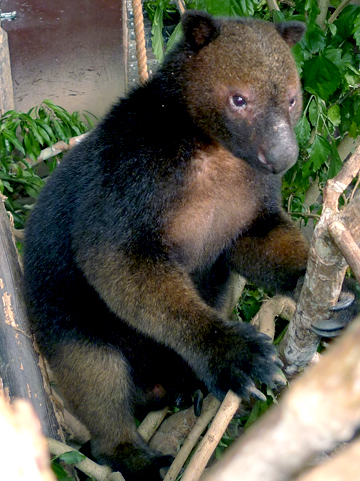 A captive Tenkile tree kangaroo. Photo courtesy of Jim Thomas. |
Euan Ritchie: It is important to conserve all species. But, in terms of tree kangaroos they are important to the local people culturally and spiritually, and feature in their stories and songs. When locals were shown camera images of the tenkile from the wild, they wept, as there are so few left and they mean so much to the local people.
Being medium-sized herbivores tree kangaroos are also likely to play a crucial role in the structure and composition of the forests they occur in. It is difficult to conserve these species, as with the improvement of health and education in recent decades, the population of the region has boomed, meaning hunting poses a real threat, and this is compounded by the threats from logging and mining. However, the transition from hunting wild animals (including tree kangaroos) for protein to eating caged rabbits, an initiative put in place by TCA (see their website), has meant numbers of some mammals and birds have grown significantly.
Mongabay: How will your camera traps help the kangaroos, and other Papua New Guinean wildlife? Do you think it will change how the public views (or doesn’t view at all) the tenkile?
Euan Ritchie: Cameras will allow us to collect data that is next to impossible to get any other way. Cameras will be surveying animals for weeks at a time and 24hrs a day. We’ll get data on where animals are found (including how high up the mountain—which is relevant to predicting the impacts of climate change), in what numbers, in what habitats and indeed, we’re probably likely to see new species and/or ones that are cryptic and not detected by other methods. The more we can show people, both locally in PNG and globally, what species reside in these forests, the more a connection and value of the wildlife will be established, which will lead to more efforts to want to conserve them. The results from camera trapping will establish a greater knowledge of the biodiversity, which in turn will create a greater awareness of the area—hopefully meaning PNG and its’ rainforest will reach a much bigger audience
Mongabay: What other animals are you expecting to see during this project?
 Torricelli Mountain Range in New Guinea. Photo courtesy of the Tenkile Conservation Alliance (TCA). |
Euan Ritchie: Weimang tree kangaroo (Critically Endangered), black-spotted cuscus (Critically Endangered), the northern glider (Critically Endangered), grizzled tree kangaroos, New Guinea quolls, wallabies, giant woolly rats, bandicoots, reptiles (in particular the Salvador’s monitor), amphibians and birds (at least four species of Birds of Paradise), LOTS!
Mongabay: How are the Torricellis—the locals of Papua New Guinea—helping the conservation of the tenkile and other local wildlife?
Euan Ritchie: Presently the Tenkile Conservation Alliance (TCA) has 50 villages within its’ program—that’s about 10,000 people. Through our education and community development programs people now have a greater respect for their environment and the special species it holds. TCA has delivered 320 water tanks to the villages over the years. These tanks have improved the life of all who use them and act as a constant reminder of their endangered species. People now consider the tenkile their gold medal and they want to keep it shining—that is they vow never to hunt it again.
Mongabay: What can people do, even those who live far away, to help the tenkile?
Euan Ritchie: Please donate at Pozible and spread the word about this project and TCA far and wide.

Children in the Toricelli Mountains. Photo courtesy of the Tenkile Conservation Alliance (TCA).

Captive weimang or golden-mantled tree-kangaroo (Dendrolagus pulcherrimus). The weimang is also found in the area and listed as Critically Endangered. Photo courtesy of the Tenkile Conservation Alliance (TCA).
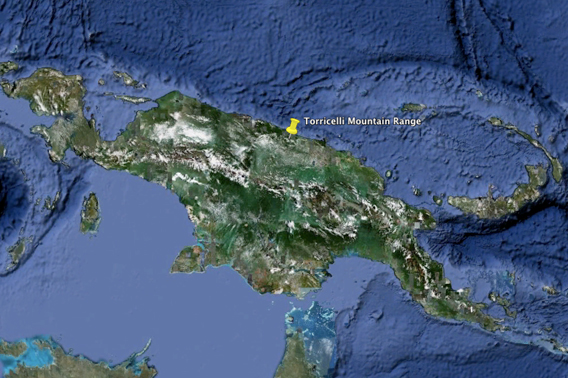
Torricelli Mountain Range on the island of New Guinea, home to the Critically Endangered Tenkile tree kangaroo. Image courtesy of Google Earth.
Related articles
Scientists describe over 100 new beetles from New Guinea
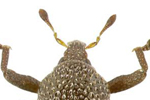
(06/03/2013) In a single paper, a team of researchers have succinctly described 101 new species of weevils from New Guinea, more than doubling the known species in the beetle genus, Trigonopterus. Since describing new species is hugely laborious and time-intensive, the researchers turned to a new method of species description known as ‘turbo-taxonomy,’ which employs a mix of DNA-sequencing and taxonomic expertise to describe species more rapidly.
Could the Tasmanian tiger be hiding out in New Guinea?

(05/20/2013) Many people still believe the Tasmanian tiger (Thylacinus cynocephalus) survives in the wilds of Tasmania, even though the species was declared extinct over eighty years ago. Sightings and reports of the elusive carnivorous marsupial, which was the top predator on the island, pop-up almost as frequently as those of Bigfoot in North America, but to date no definitive evidence has emerged of its survival. Yet, a noted cryptozoologist (one who searches for hidden animals), Dr. Karl Shuker, wrote recently that tiger hunters should perhaps turn their attention to a different island: New Guinea.
Getting intimate with a giant, yet poorly known flightless bird: the cassowary
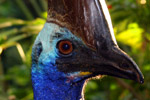
(01/23/2013) For large, conspicuous, and somewhat notorious animals, relatively little is known about cassowaries, a group of flightless birds that roams the rainforests of Northern Australia and New Guinea. This fact is highlighted in Cassowaries, a recent documentary by Australian journalist and film producer Bianca Keeley. Cassowaries tells the story of cassowaries struggling to survive after a major cyclone destroyed their rainforest home.
Scientists: bizarre mammal could still roam Australia
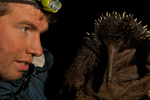
(01/03/2013) The continent of Australia is home to a wide variety of wonderfully weird mammals—kangaroos, wombats, and koalas among many others. But the re-discovery of a specimen over a hundred years old raises new hopes that Australia could harbor another wonderful mammal. Examining museum specimens collected in western Australia in 1901, contemporary mammalogist Kristofer Helgen discovered a western long-beaked echidna (Zaglossus bruijnii). The surprise: long-beaked echidnas were supposed to have gone extinct in Australia thousands of years ago.
New Guinea singing dog photographed in the wild for the first time
(12/03/2012) A rarely seen canine has been photographed in the wild, likely for the first time. Tom Hewitt, director of Adventure Alternative Borneo, photographed the New Guinea singing dog during a 12-day expedition up a remote mountain in Indonesian Papua. Very closely related to the Australian dingo, the New Guinea singing dog, so named for its unique vocalizations, has become hugely threatened by hybridization with domesticated dogs.
Photo: New ‘bumblebee’ gecko discovered in New Guinea
(04/18/2012) Researchers from the Papua New Guinea National Museum and the U.S. Geological Survey have discovered a new species of gecko on an island off the coast of New Guinea.
Police hired by loggers in Papua New Guinea lock locals in shipping containers
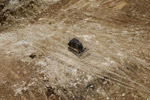
(04/16/2012) Locals protesting the destruction of their forest in Papua New Guinea for two palm oil plantations say police have been sent in for a second time to crack-down on their activities, even as a Commission of Inquiry (COI) investigates the legality of the concession. Traditional landowners in Pomio District on the island East New Britain say police bankrolled by Malaysian logging giant Rimbunan Hijau (RH) have terrorized the population, including locking people in shipping containers for three consecutive nights. The palm oil concessions belongs to a company known as Gilford Limited, which locals say is a front group for RH.
Papua New Guinea halts controversial nickel mine – for now
(04/16/2012) A massive, controversial nickel mine has been shut down in Papua New Guinea due to the environmental concerns of its slurry pipeline, reports Cultural Survival. Inspections of the 83 mile (134 kilometer) slurry pipeline found that it had been built too close to a major highway with spills already impacting traffic. Built by the Chinese state company Metallurgical Construction Corporation (MCC), the Ramu Nickel Mine has been plagued by land issues, labor disputes, and environmental concerns.
More than 1 million acres of New Guinea forest cut from Indonesia’s forest moratorium
(02/16/2012) More than 400,000 hectares of land — including 350,000 hectares of peatland — in Indonesian New Guinea lost their protected status during a November 2011 revision of Indonesia’s moratorium on new forest concessions, reports a new analysis by Greenomics-Indonesia, a Jakarta-based NGO.
New book series hopes to inspire research in world’s ‘hottest biodiversity hotspot’

(01/17/2012) Entomologist Dmitry Telnov hopes his new pet project will inspire and disseminate research about one of the world’s last unexplored biogeographical regions: Wallacea and New Guinea. Incredibly rich in biodiversity and still full of unknown species, the region, also known as the Indo-Australian transition, spans many of the tropical islands of the Pacific, including Indonesia’s Sulawesi, Komodo and Flores, as well as East Timor—the historically famous “spice islands” of the Moluccan Archipelago—the Solomon Islands, and, of course, New Guinea. Telnov has begun a new book series, entitled Biodiversity, Biogeography and Nature Conservation in Wallacea and New Guinea, that aims to compile and highlight new research in the region, focusing both on biology and conservation. The first volume, currently available, also includes the description of 150 new species.
Papua New Guinea suspends controversial grants of community forest lands to foreign corps
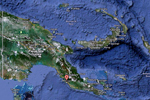
(05/06/2011) The government of Papua New Guinea yesterday suspended its controversial Special Agricultural and Business Leases program which has granted logging and plantation development concessions to mostly foreign corporations across 5.2 million hectares of community forest land, reports the Courier-Post